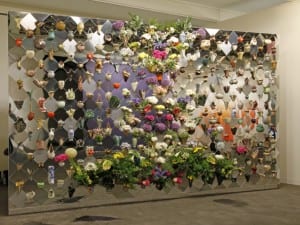In the Special 60th Edition of Aesthetica we celebrate the emerging photographers that are shaping the future of the image-based practice in The Next Generation. We have partnered with the London College of Communication to survey some of photography’s rising stars and showcase their fresh ideas and new concepts. Juno Calypso works with self-portraiture to explore the artificial construction of femininity. Her fictional character, Joyce, allows her to combine personal experience with critical studies into modern rituals of beauty and seduction.
A: Your image, A Modern Hallucination, is currently in Issue 60 of Aesthetica, can you explain the concept behind this image?
JC: The initial concept behind that image was to try and answer the question: How quickly can I dress up and take a picture of myself in my grandma’s bedroom before she gets home? I didn’t know how to explain what I was doing at that stage so I just tried to do it without people knowing instead. The title of the image, A Modern Hallucination, is a quote taken from a book called The Beauty Myth by Naomi Wolf. I’d been developing ideas around a character paralysed by her obsession with self-improvement and the artificial construct of femininity, and there was a bit that stood out where the author drew comparison between the beauty industry and forms of medieval torture: “The Iron Maiden was a body-shaped casket painted with the limbs and features of a lovely, smiling young woman. The unlucky victim was slowly enclosed inside her; the lid fell shut to immobolize the victim, who died either of starvation or, less cruelly, of the metal spikes embedded in her interior. The modern hallucination in which women are trapped or trap themselves is similarly rigid, cruel, and euphemistically painted.”
A: You work a lot with self-portraiture and have created a character called Joyce, what drew you to this idea?
JC: I wanted to take photos of people but I was always better at taking pictures when I was alone, so self-portraiture was my only way around that. It was still a private thing for a very long time – an offshoot of the kind of pictures you’d take of yourself in your bedroom as a teenager. My tutor at LCC was the one who helped pull this private work to the surface after I showed her a series of pictures I’d taken of myself posing on a desk wearing gold rimmed glasses, fake teeth and a peach two-piece suit. That was the start of what eventually became Joyce.
A: What do you want viewers to take from your images?
JC: When you’ve staged an image, it’s good to see an audience become absorbed and confused by the details. Uncomfortable laughter is also good. My favourite reaction, which I didn’t anticipate, is from a lot of women who’ve told me that they relate to the character in the work – that they recognise those isolated moments of frustration, boredom and exhaustion, and felt relieved to see light being thrown onto those private rituals.
A: Which photographers have inspired you over the years?
JC: When I was younger I really liked Nobuyoshi Araki, David La Chappelle, Gregory Crewdson and Erwin Olaf – anyone colourful or controversial. When I began working with staged self-portraiture I looked a lot at Cindy Sherman, Nikki S. Lee, Gillian Wearing, Sandy Skoglund, Samuel Fosso and Sarah Maple. Recently I’ve found a lot of inspiration from watching films by directors such as Matthew Barney, John Waters, Pedro Almodovar and Roy Andersson.
A: What do you have planned for the future?
JC: For the near future, I’m continuing to make new photographic, sculpture and video work, while also working freelance as an art director on short films and music videos. For the distant future, we’ll see.
Pick up Issue 60 of Aesthetica at www.aestheticamagazine.com
To find out more about Juno Calypso, visit www.junocalypso.com
Credits
1. Juno Calypso, A Modern Hallucination, from the series Joyce, 2012.
Follow us on Twitter @AestheticaMag for the latest news in contemporary art and culture.





